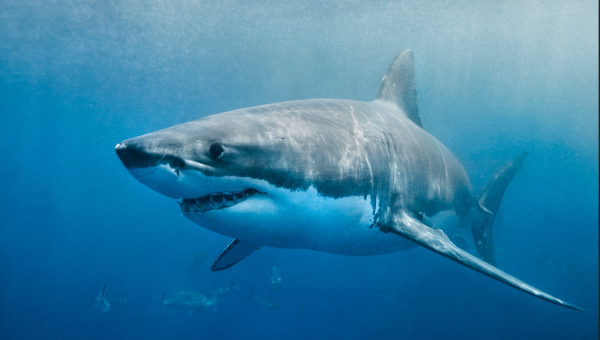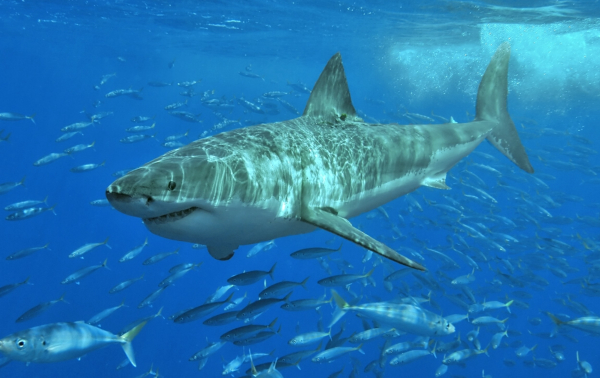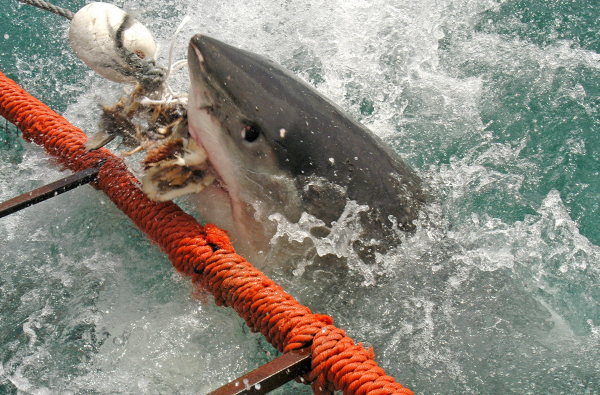
Great whites are known to be on the increase in the northeast, but they also appear to be more numerous in the Gulf of America these days. (NOAA Fisheries)
For decades, the idea of great white sharks patrolling the Gulf of Mexico/America was more lore than fact—something whispered among old-timers near the oil rigs or dramatic fodder for late-night beach campfires. Yet in recent years, the Gulf has seen an uptick in confirmed great white sightings by those who can tell the difference.
So what’s behind this shift? And why now?
Historically, great white encounters in the Gulf were rare, evidenced only by a few bycatch records from the 1930s and early 1940s, and sporadic longline bycatch in the late 20th century. Whites are known to prefer cool water and warm-blooded prey like seals, both of which are absent in the Gulf.
But fast-forward video footage of a great white off Tampa (February 2025), and another near Destin (April 2025) have surfaced just this year. And several have been caught by shore anglers, right off the beaches of Santa Rosa Island. One was also caught from the Navarre Beach pier.
Enter Ocearch and their satellite-tracking network. The non-profit captures and tags adult great whites, mostly off New England in summer, then reports on their website as the giants migrate annually.
They now report that tagged sharks like “Crystal” and “Keji” have been recorded entering the Gulf and swimming as far north as Sarasota and Cape Coral in winter, before migrating back into the open Atlantic and heading north for the summer.
Add these observations to those of anglers and offshore yachtsmen and it’s pretty clear: the Gulf of America is now great white shark habitat, even though they’re far from abundant.
Are the Sharks Increasing—or Just More Seen?
Part of the spike in visibility could simply be due to better cameras, drones, and more boats offshore with vigilant observers. Most offshore anglers now know what a great white looks like, as distinguished from a mako or other offshore species. And more boats, powered by multiple big outboards, are making the run offshore to bring home everything from red snapper to yellowfin tuna, wahoo and blue marlin.
Meanwhile, conservation measures enacted since the early 1990s have bolstered Atlantic white shark populations as well as many other species in U.S. waters. Protected from harvest since 1993, their populations are slowly rising—potentially increasing seasonal spillover into Gulf waters.

White sharks take many years to reach maturity, part of the reason for their slow population increase, but they definitely appear to be more numerous in U.S. east coast waters. (Wikimedia Commons)
What’s Luring Them South? The Role of Prey and Currents
Great whites may be exploiting ecological opportunities in the Gulf:
- Prey bonanzas: A hypothesis by independent researcher Hayden Marshall Smith envisions the Gulf of Mexico as a “fallback biomass refuge”—a place whites retreat to during seasonal surges of prey like blackfin tuna with low competition or danger from other apex predators like orca’s, which are known great white predators.
- Ocean currents: The Loop Current, a large vortex passing between the Yucatan Peninsula and the Florida Keys and sweeping all the way up to the Mississippi River Delta, may serve as a natural highway, transporting large pelagics—including displaced or subadult whites—from the Atlantic into the Gulf. The edges of the loop are often loaded with bait and gamefish, too, providing lots of forage for sharks.
- More sharks: More sharks of other species also provide fodder for great whites, which are known to regularly prey on other sharks as well as their own young at times.
Together, these factors suggest that whites aren’t randomly wandering—they may be actively exploring Gulf waters when ecological conditions align.
Climate Change: Hotter Waters, But Not Too Hot?

Whites eat just about anything they can catch or find, but among their favorite prey species are the warm-blooded seals, totally absent in the Gulf of America. (Wikipedia)
It seems counterintuitive that great whites, which prefer cooler waters (roughly 50–80°F), are venturing into a warming Gulf. But from late fall through winter and early spring, temperatures are just right for them—and many of the fish which they feed on are available in the waters of the loop current during winter.
The Gulf doesn't appear to host resident whites—it’s more of a seasonal waypoint, possibly used by younger or adventurous individuals when conditions align.
Great whites are rare—but no longer invisible—in Gulf waters. (They’re not abundant anywhere, though numbers seem to be growing steadily north of Cape Hatteras.) Their visits seem driven by prey, currents, and recovery of the species, rather than random wanderlust or warmer seas. They're not here to stay—but for the moments they are, it's a testament to shifting oceans and improving conservation.
— Frank Sargeant
Frankmako1@gmail.com